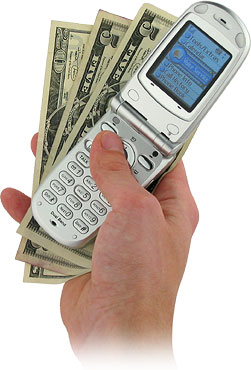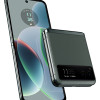Prepaid Exposed
Nov 4, 2003, 7:00 PM by Carlos Espinal
Special report. Everything you wanted to know about prepaid wireless but were afraid to ask.
Prepaid services have changed since this article was published in 2003. It is not updated to reflect current prepaid offerings.

The goal of this article is to compare North American carriers' prepaid plans. This article sets out to cover the differences in pricing structures of major North American Prepaid options, and compare them to each other and to, what I believe to be, an ideal plan. This article is not geared to be an analysis of carrier network quality or coverage.
Prepaid plans have been around for a long time. They have had many different faces, from the old school public phones that take coins, to the latest prepaid wireless plans. However, because the nature of telecommunication services is constantly changing, the old prepaid model is not necessarily one that fits well into modern day wireless services.
The need for wireless prepaid plans stemmed mainly from three groups of users that wanted to have standard wireless service but could not obtain it or did not want to be bound by a contract. Poor credit ratings are the main culprit behind people not being able to qualify for traditional monthly plans. Transients, as in those not planning on remaining in the area long enough to be bound by a contract (e.g. Tourists) are the second group, and lastly potential customers that simply disagree with having to be bound to a wireless contract make up the last group. Because of these groups of people, wireless companies started releasing prepaid plans, but reluctantly so, for they aren't always the most desirable (and lucrative) type of customer for a carrier to have.
The prepaid customer is one whose annual revenue for the company can't be accurately predicted. In some cases, a prepaid customer may only use the phone on occasion, and others, frequently enough to cover the cost of his subsidy, the subsidy of others, and still provide some revenue.
This brings us to the topic of phone subsidies. Phones, and their sales prices are traditionally subsidized for initial buyers of wireless services. This is to provide a lower entry price point for new customers. Phones straight from the factory are actually quite expensive. That phone you might be getting for free or for $50 from the carrier may have actually cost the carrier around $200 or more. The carrier needs to make this money back. Thus prices for plans need to reflect that subsidy. In general, the three factors that contribute to the pricing of Prepaid Plans are:
- The Phone subsidy that is required to price the new customer kits at a reasonable entry price.
- The uncertainty of a consistent revenue flow from individual prepaid customers.
- The costs of having to design a wireless infrastructure and customer service employee pool to service an unpredictable number of prepaid customers, far and above of the scheduled monthly contractual customers.
Because of these factors, prices are, and will continue to be, higher for prepaid customers than for regular customers. As we will see in the following sections, price is something that will vary quite a bit from carrier to carrier. Subsidies aside, the pricing of prepaid plans are also based on the quality of the network coverage (and the expense that it was for the carrier to make the network), the services offered to prepaid customers, and the cost of the actual phone that is bundled with the starter packages.
The variables when choosing a prepaid plan are just as many as when selecting a regular monthly plan. You still have to make sure that the carrier has coverage where you plan to use it, you have to make sure that the plan covers your communication needs (voice, data, texting, or all of them), and whether the pricing makes sense to you. The combination of these variables can seem daunting to the uninitiated, thus the following quick summaries of the carrier's offerings set out to shed some light on the subtle differences between the options.
Verizon
Verizon's prepaid plan is called FreeUp. It includes text messaging, caller ID, voicemail, and long distance. The way it works is actually rather simple, and is close to my 'ideal plan' that I will explain later.
In order to start using your prepaid phone, you buy a prepaid kit, which includes the phone and a card for some dollar amount of credit. Then you use this dollar amount and/or subsequent dollar amounts you add via ReUP cards, to pay for your usage. They have differing rates for weekday minutes (most expensive), Mobile to Mobile minutes, Night and Weekend Minutes, Text messaging, Off-Network roaming, and international. All these rates are automatically debited from your card amount.
The biggest disadvantage, in my opinion, to Verizon's prepaid service, is its cost relative to the others. It's not the cheapest by any means. In addition, they, along with all the other carriers, have set expiration dates for minutes you buy, so if you buy a card to ReUP your phone, you still have to use them within an allotted period, or they'll expire. This period varies by the dollar amount of your refill card. In addition, I don't quite appreciate that Verizon doesn't offer their prepaid customers access to their Express network as of yet. The Express network is Verizon's 1xRTT network that allows for phones, or data cards to have data at speeds around 60Kbps. What would have been nice is if you could buy a prepaid data card for your laptop, for example, so that only when you were going to travel would you have to pay for the service (via prepay), rather than having to be bound by a contract.
For more information go to:
T-Mobile
T-Mobile is a curious case when it comes to prepaid. It has historically had a lock on all foreign tourist traffic, roaming or via prepaid, because of having the largest GSM network in America, yet they choose to limit how they can make money on their prepaid options.
For example, you cannot 'formally' buy a SIM card from T-Mobile in order to have prepaid service with them. Yes, there are several shops that will sell them to you without a phone package, but they're not supposed to do that. Those stores typically dissect the prepaid packages and sell the SIM and phone separately. Additionally, T-mobile will not allow their prepaid customers to use the GPRS network, nor do they offer any prepaid services (easily found) on their website.. It's almost like they have disdain for the prepaid customer.
However, if you're used to GSM service, and you're only here in the USA for a short period of time, T-Mobile still has the largest GSM network in America, with AT&T and Cingular quickly catching up.


 Hands On with the moto g stylus 5G (2023)
Hands On with the moto g stylus 5G (2023)
 Hands On with the Boost Summit 5G
Hands On with the Boost Summit 5G
 Hands On with the 2025 Moto razr Lineup
Hands On with the 2025 Moto razr Lineup
 Motorola's new razr Foldable is Just $600
Motorola's new razr Foldable is Just $600
 iOS 18 Overhauls Home Screen, Messaging, Photos
iOS 18 Overhauls Home Screen, Messaging, Photos

